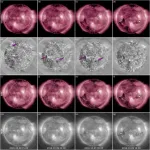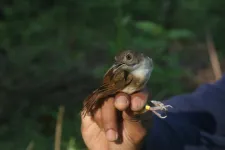(Press-News.org) On 23 July 2012, humanity escaped technological and economic disaster. A diffuse cloud of magnetized plasma in the shape of a slinky toy tens of thousands of kilometers across was hurled from the Sun at a speed of hundreds of kilometers per second.
This coronal mass ejection (CME) just missed the Earth because its origin on the Sun was facing away from our planet at the time. Had it hit the Earth, satellites might have been disabled, power grids around the globe knocked out, GPS systems, self-driving cars, and electronics jammed, and railway tracks and pipelines damaged. The cost of the potential damage has been estimated at between $600bn and $2.6trn in the US alone.
While CMEs as large as the 2012 event are rare, lesser ones cause damage on Earth about once every three years. CMEs need between one and a few days to reach Earth, leaving us some time to prepare for the potential geomagnetic storm. Current efforts to limit any damage include steering satellites out of harm's way or redirecting the power load of electrical grids. But many CMEs -- called 'stealth CMEs' because they don't produce any clear signs close to the Sun's surface -- aren't detected until they reach Earth.
Now, an International Space Science Institute (ISSI) team of scientists from the US, Belgium, UK, and India shows how to detect potentially damaging stealth CMEs, trace them back to their region of origin on the Sun, extrapolate their trajectory, and predict if they will hit Earth. The results were recently published in the journal Frontiers in Astronomy and Space Sciences.
Visualizing the invisible
"Stealth CMEs have always posed a problem, because they often originate at higher altitudes in the Sun's corona, in regions with weaker magnetic fields. This means that unlike normal CMEs -- which typically show up clearly on the Sun as dimmings or brightenings -- stealth CMEs are usually only visible on devices called coronagraphs designed to reveal the corona," said corresponding author Dr Erika Palmerio, a researcher at the Space Sciences Laboratory of the University of California at Berkeley.
"If you see a CME on a coronagraph, you don't know where on the Sun it came from, so you can't predict its trajectory and won't know whether it will hit Earth until too late."
Palmerio continued: "But here we show that many stealth CMEs can in fact be detected in time if current analysis methods for remote sensing are adapted. Put simply, we compared 'plain' remote sensing images of the Sun with the same image taken between eight and 12 hours earlier, to capture very slow changes in the lower corona, up to 350,000km from the Sun's surface. In many cases, these 'difference images' revealed small, previously overlooked changes in the loops of magnetic fields and plasma that are hurled from the Sun. We then zoom in on these with another set of imaging techniques to further analyze the stealth CME's approximate origin, and predict whether it is headed towards Earth."
Stealth CMEs leave overlooked signs
Palmerio and collaborators looked at four stealth CMEs that occurred between 2008 and 2016. Unusually for stealth CMEs, their origin on the Sun was approximately known only because NASA's twin STEREO spacecraft, launched in 2006, had happened to capture them 'off-limb'. This means it was viewed outside the Sun's disc from another angle than from Earth.
With the new imaging techniques, the authors revealed previously undetected, tiny dimmings and brightenings on the Sun at the region of origin of all four stealth CMEs. They conclude that the technique can be used for the early detection of risky stealth CMEs.
"This result is important because it shows us what to look for if we wish to predict the impact on Earth from solar eruptions," said Palmerio.
"Another important aspect of our study -- using geometric techniques to locate a CME's approximate source region and model its 3D structure as it expands and moves towards Earth -- can only be implemented when we have more dedicated observatories with different perspectives, like the STEREO spacecraft."
The authors predict that the new European Space Agency's Solar Orbiter, launched in February 2020, will help with this, just like similar initiatives which are currently discussed by researchers worldwide.
"Data from more observatories, analyzed with the techniques developed in our study, could also help with an even more difficult challenge: namely to detect so-called 'super stealth CMEs', which don't even show up on coronagraphs," said coauthor Dr Nariaki V Nitta, a senior researcher at Lockheed Martin Solar and Astrophysics Laboratory in Palo Alto, US.
INFORMATION:
Retail traders often fear that reducing the amount of urban space made available for parking private vehicles would have a negative effect on their businesses. A survey conducted by researchers from the Institute for Advanced Sustainability Studies (IASS) on two shopping streets in Berlin shows that traders have a skewed perception of their customers' mobility habits. The findings of this research will facilitate better-informed decision-making around urban land-use planning.
The researchers surveyed around 2,000 customers and 145 retailers on Kottbusser Damm (Friedrichshain-Kreuzberg district) and Hermannstraße (Neukölln district). The vast majority of shoppers - 93 per cent - had not travelled to their ...
No benefit of high-flow therapy (HFT) can be derived from the available study data for patients with advanced chronic obstructive pulmonary disease (COPD) or chronic type 1 respiratory failure. It therefore remains unclear whether this form of treatment has advantages over long-term oxygen therapy (LTOT) or non-invasive ventilation (NIV).
This is the conclusion of the benefit assessment that the Institute for Quality and Efficiency in Health Care (IQWiG) has now completed. The Federal Joint Committee (G-BA) had commissioned IQWiG to investigate the advantages and disadvantages of HFT in patients with stable, advanced COPD or chronic respiratory failure with oxygen deficiency ...
These motions were measured by analyzing 10 years of observations from NASA's Solar Dynamics Observatory (SDO). Using computer models, the scientists have shown that the newly discovered oscillations are resonant modes and owe their existence to the Sun's differential rotation. The oscillations will help establish novel ways to probe the Sun's interior and obtain information about our star's inner structure and dynamics. The scientists describe their findings in today's issue of the journal Astronomy & Astrophysics.
In the 1960s the Sun'ss high musical notes were discovered: The Sun rings like a bell. ...
New findings from zoologists working with birds in Southeast Asia are shining fresh light on the connections between animal behaviour, geology, and evolution - underlining that species can diversify surprisingly quickly under certain conditions.
The zoologists, from Trinity College Dublin's School of Natural Sciences, sequenced DNA and took measurements and song recordings from Sulawesi Babblers (Pellorneum celebense), shy birds that live in the undergrowth on Indonesian islands.
Although these islands were connected by land bridges just tens of thousands of years ago, and although the babblers look ...
One of the leading thinkers in nano-science has called on the energy materials community to help finally put an end to the world's reliance on fossil fuels.
In a hard-hitting editorial published by Energy and Environmental Materials, Professor Ravi Silva, Director of the Advanced Technology Institute (ATI) at the University of Surrey, argues that there are no coherent excuses left to justify the use of fossil fuels. In his paper, Professor Silva challenges the scientific community to lead the world away from a reality where fossil fuels still account for 80 per cent of the energy mix.
While the cost of clean energy generation has plummeted over recent years, ...
Hydropower has massive potential as a source of clean electricity, and the Indus basin can be a key player in fulfilling long-term energy storage demands across Africa, Asia, Europe, and the Middle East. IIASA researchers explored the role the Indus basin could play to support global sustainable development.
According to the International Energy Agency (IEA), the growth of hydropower plants worldwide is set to slow down this decade. This puts at risk the ambitions of countries across the globe aiming to reach net-zero emissions while ensuring reliable and affordable energy supplies for their citizens. Even so, there are thousands of dams planned to be built this next decade. New hydropower dams installed worldwide are forecasted to increase global hydroelectricity ...
Decreasing bacterial acidity could help reduce antimicrobial resistance by eliminating bacteria that can survive being treated with antibiotics.
Scientists at the University of Exeter have developed a novel method, which allows users to measure the pH of individual bacteria before, during and after treatment with antibiotics.
The research, published in the journal mBio, lays the foundation for understanding the special properties of bacteria that survive being treated with antibiotics, so that new ways of targeting them can be developed.
The Exeter University research team found that even before antibiotic treatment, common infection causing Escherichia coli cells that can survive treatment have a more acidic intracellular pH compared to clonal cells that are eliminated ...
Interstellar clouds are the birthplaces of new stars, but they also play an important role in the origins of life in the Universe through regions of dust and gas in which chemical compounds form. The research group, molecular systems, led by ERC prize winner Roland Wester at the Institute for ion physics and applied physics at the University of Innsbruck, has set itself the task of better understanding the development of elementary molecules in space. "Put simply, our ion trap allows us to recreate the conditions in space in our laboratory," explains ...
Amsterdam, July 20, 2021 - Well over six million people globally have been diagnosed with Parkinson's disease (PD), which has an enormous impact on the lives of patients, their families, and caregivers and is incurring mounting costs for society. This special supplement to the Journal of Parkinson's Disease (JPD), guest-edited by noted experts Anat Mirelman, PhD, E. Ray Dorsey, MD, MBA, Patrik Brundin, MD, PhD, and Bastiaan R. Bloem, MD, PhD, reviews how digital technology is being used to reshape research and clinical care in PD.
Digital health technology is an umbrella term that spans a diverse range of applications, including body-fixed wearable sensors, non-contactable domestic sensors, smartphone apps, and videoconferencing and other telemedicine systems that allow for direct remote ...
MINNEAPOLIS/ST. PAUL (07/20/2021) -- National data analyzed by University of Minnesota Medical School researchers show that nearly 40 percent of all funds used to pay for medical school are expected to come from family or personal sources and scholarships. The prevalence of these sources, however, varies widely by race and socioeconomic status.
Arman Shahriar, Varun Sagi and Lorenzo Gonzalez, all fourth-year students at the University of Minnesota Medical School, are co-lead authors of the study, which was published today in JAMA Network Open.
"Financing a four-year medical education requires upwards of a quarter-million dollars, and this amount has been rising faster than inflation since the 1960s. Prior to this study, ...



